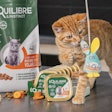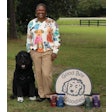
When it comes to what they put in their pets' bowls, today's consumers demand the best quality and nutrition. That means petfood manufacturers and suppliers must develop and select every ingredient and component of a formulation for maximum effect.
Perhaps in no category does this ring more true than palatability. "Industry and customers have required that we take a completely different approach to palatability," said Jennifer Radosevich, PhD, director of R&D and regulatory affairs for Kemin Nutrisurance Inc., in a presentation at the Colegio Brasileiro de Nutricao Animal in Brazil in 2008. "They want to know our products not only taste good but also have nutritional or functional value."
Probiotic power
As more and more consumers seek to provide the same nutritional benefits to their pets that they enjoy, they're also looking for ways to ensure consumption of healthy petfoods. The availability of good tasting foods containing probiotics is leading to rapid growth in this category.
Unfortunately, says AFB International, most probiotic species do not survive well in dry petfoods due to the low water activity. Few live strains of probiotics survive the stomach acids or bile acids to actually reach the gut in a viable state. Through a partnership with Ganeden Biotech Inc., AFB has recently created a new palatant to address this problem.
This new product contains GanedenBC30, live spores of a patented strain of Bacillus coagulans. The strain is generally recognized as safe and approved by the US Food and Drug Administration's Center for Veterinary Medicine as a direct-fed microbial, according to AFB.
GanedenBC30 is currently available in a variety of human food products, providing a link between benefits for owners and their pets. The spore-forming nature of this strain allows petfood marketers to use the probiotics in their existing manufacturing process, applying either liquid or dry palatants to the surface, without worry about spore survival, AFB says. Key benefits of this approach include more uniform distribution of the probiotics and survival throughout the shelf-life of the petfood product (Figure 1). This brings active cultures to pets on a daily basis through their normal diets, eliminating issues with pets not accepting a supplement.
The spores' germination is triggered by the transition through the pH changes between the stomach and the intestinal tract. The pet's own system becomes the means to activate the probiotics at the appropriate time. According to AFB, growth of the probiotics in the intestinal tract brings:
- Improved digestive health through the production of lactic acid;
- Improved breakdown of nutrients for better absorption; and
- Displacement of undesirable bacteria in the gut.
Feeding studies conducted by AFB have shown growth of the probiotics in the gut with a 780% increase in fecal spore counts after only seven days on the feed. Currently the product is available in the US and Canada.
Immune response boost
Kemin employs a total palatability approach to fulfill consumer requirements for petfoods that combine health benefits with taste. This approach, Radosevich says, "generates thousands of compounds to add/detract to palatability but also can affect the health of the animal." Kemin demonstrated the effects by adding a functional ingredient to a palatant and studying the response through nutrigenomics.
Nutrigenomics is the study of how particular nutrients effect the expression of genes in the DNA of a living animal. Kemin looked at linking diet with gene expression via a trace mineral nutrigenomics experiment, a non-invasive study with Beagles examining the effects on gene expression in white blood cells after supplementation with one of the company's products, KemTrace Zinc.
The immune response effects included:
- Increased toll-like receptor expression. These proteins on the surface of immune cells are critical in recognizing substances foreign to the body and form the first line of defense against bacterial invasion;
- Increased interferon-g receptor expression. Interferon-g is a major cytokine (signaling compound) secreted by a variety of cells that is crucial to controlling infections and tumor growth;
- Upregulated genes. Zinc supplementation upregulated genes encoding structural proteins required for wound repair.
Taking advantage of technology
Adding dual functionality to palatants is driven by growing petfood market sophistication (for example, health value) and the need for manufacturers to find cost-effective formulations, according to SPF. Because palatants are commonly used topically and are not subject to drastic process conditions, they are ideal vectors for sensitive compounds such as nutraceuticals or heat sensitive chemicals, SPF says.
Also, technologies used to produce palatants can be applied to create other compounds with functionality besides just palatability. SPF is including this capability at an early phase of product development and has developed innovative technologies to add functionalities to the palatant. SPF offers specific solutions answering precisely the needs of this emerging segment-for example, a palatant for hypoallergenic diets.














